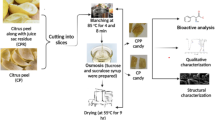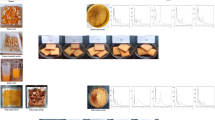Abstract
Citrus fruits are consumed either as whole fruits or as juice after processing. Processing of fruits yields a significant number of by-products in the form of pulp, peel and seeds, which are often discarded and major cause of environmental concern. Bitterness in the waste residue of citrus products is one of the leading hindrance in its valorization and supplementation in other food products. Aim of this study was to reduce the bitterness of Citrus reticulata (kinnow) pomace using enzymatic method and its supplementation in production of nutritionally rich pasta. Under optimized conditions (1U/mg enzyme naringinase concentration, temperature 50 °C, at pH 4.5 and treatment time 4 h), the maximum reduction (65.95%) of naringin (bitterness causing compound) was observed coupled with increase (60.13%) in naringenin (non-bitter compound). The debittered kinnow pomace has been further characterized for physio-chemical changes and morphological changes before and after treatment. The debittered kinnow pomace was then supplemented for the preparation of antioxidant and nutrient enriched pasta.





Similar content being viewed by others
References
Amerine MA, Pangborn RM, Roessler EB (1965) Principles of sensory evaluation of food. (Academic Press, Elsevier, London, UK,) pp. 602.
AOAC (2000) Association of official Analytical Chemists, 16th edn. Washington, USA.
Bustamante J, Van Stempvoort S, García-Gallarreta M, Houghton JA, Briers HK, Budarin VL, Matharu AV, Clark JH (2016) Microwave assisted hydro-distillation of essential oils from wet citrus peel waste. J Clean Prod 137:598–605
Chamorro S, Viveros A, Alvarez I, Vega E, Brenes A (2012) Changes in polyphenol and polysaccharide content of grape seed extract and grape pomace after enzymatic treatment. Food Chem 133:308–314
De-Silva GOS, Marapana R, Manawaduge R (2017) Effect of naringinase enzymatic treatment on the bitter compound naringin in fresh juice of “Bibila sweet” oranges. J Pharma Phytochem 6(4):174–178
FAOSTAT (2012) Food and Agricultural Organization of the United Nations. http,//faostat.fao.org/site/567/default.aspx? Page ID=567#ancor/, (accessed 10.10.14.).
Ferreria LR, Macedo JA, Ribeiro ML, Macedo GA (2013) Improving the chemo-preventive potential of orange juice by enzymatic biotransformation. Food Res Int 51:26–535
Grewal MK, Chandrapala J, Donkor O, Apostolopoulos V, Stojanovska L, Vasiljevic T (2017) Fourier transform infrared spectroscopy analysis of physicochemical changes in UHT milk during accelerated storage. Int Dairy J 66:99–107
Hou L, Wang J, Zhang D (2013) Optimization of debittering of soybean antioxidant hydrolysates with β-cyclodextrins using response surface methodology. J Food Sci Technol 50(3):521–527
Jung CH, Seog HM, Choi IW, Park MW, Cho HY (2006) Antioxidant properties of various solvent extracts from wild ginseng leaves. LWT-Food Science and Technology 39:266–274. https://doi.org/10.1016/j.lwt.2005.01.004
Lario Y, Sendra E, Garcia-Perez J, Funentes C, Sayas-Barbera E, Fernandez-Lopez J, Perez-Alvarez JA (2004) Preparation of high dietary fiber powder from lemon juice by-products. Innov Food Sci Emer Technol 5:113–117
Lowry OH, Rosenbrough NJ, Farr A, Randall RJ (1951) Protein measurement with the Folin phenol reagent. J Biol Chem 193:265–275
Mahawar MK, Bibwe B, Jalgaonkar K, Ghodki BM (2019) Mass modeling of kinnow mandarin based on some physical attributes. J Food Process Eng. https://doi.org/10.1111/jfpe.13079
Marín FR, Soler-Rivas C, Benavente-García O, Castillo J, Pérez-Alvarez JA (2007) By-products from different citrus processes as a source of customized functional fibers. Food Chem 100(2):736–741
Markoska T, Huppertz T, Grewal MK, Vasiljevic T (2019) FTIR analysis of physiochemical changes in raw skim milk upon concentration. LWT 102:64–70
Mejia EG, Conrado NR, Gonzalez MEL, Madrid Y (2019) Citrus peels waste as a source of value-added compounds: extraction and quantification of bioactive Polyphenols. Food Chem 295:289–299
Mushtaq M, Sultana B, Bhatti HN, Asgher M (2014) Optimization of enzyme-assisted revalorization of sweet lime (Citrus limetta Risso) peel into phenolic antioxidants. BioResources 9(4):6153–6165
Nasir M, Khan AS, Ahmad Basra SMA, Malik AU (2016) Foliar application of moringa leaf extract, potassium and zinc influence yield and fruit quality of ‘Kinnow’ mandarin. Sci Hortic 210:227–235
Panesar PS, Panesar R, Singh B (2009) Application of response surface methodology in the optimization of process parameters for the production of kinnow wine. Nat Prod Rad 8(4):366–373
Prakash S, Singhal RS, Kulkarni PR (2002) Enzymic debittering of Indian grapefruit (Citrus paradis) juice. J Sci Food Agric 82:394–397
Patil MB, Dhake AB (2014) Debittering of citrus fruit juice by naringinase of Penicillium purpurogenum. Int J Eng Sci Technol 3(2):266–270
Puri M, Banerjee UC (2000) Production, purification, and characterization of the debittering enzyme naringinase. Biotechnol Adv 18:207–217
Rafiq S, Kaul R, Sofi SA, Bashir N, Nazir F, Ahmad Nayik G (2018) Citrus peel as a source of functional ingredient: a review. J Saudi Soc Agric Sci 17(4):351–358
Radhakrishnan I, Sampath S, Kumar S (2013) Isolation and characterization of enzyme naringinase from Aspergillus flavus. Intl J Adv Biotechnol Res 4(2):208–212
Rosenthal A, Pyle DL, Niranjan K (1996) Aqueous and enzymatic processes for edible oil extraction. Enz Micro Technol 19:402–420
Satari B, Karimi K (2018) Citrus processing wastes: environmental impacts, recent advances, and future perspectives in total valorization. Res Conserv Recycl 129:153–167
Seal T (2016) Quantitative HPLC analysis of phenolic acids, flavonoids and ascorbic acid in four different solvent extracts of two wild edible leaves, Sonchus arvensis and Oenanthe linearis of North-Eastern region in India. J App Pharma Sci 6:157–166
Sharma N, Kalra KL, Oberoi H, Bansal S (2007) Optimization of fermentation parameters for production of ethanol from kinnow waste and banana peels by simultaneous saccharification and fermentation. Ind J Microbiol 47(4):310–316
Sharma V, Bhardwaj A (2019) Chapter 29-Scanning electron microscopy (SEM) in food quality evaluation Evaluation Technologies for Food Quality Wood head Publishing Series in Food Sci, Technol Nutr, 743–761.
Singla G, Krishania M, Sandhu PP, Sangwan RS, Panesar PS (2019) Value addition of kinnow juice processing industry by-products using green solvents. J Pharma Phytochem., SP1, 19–22.
Shimada K, Fujikawa K, Yahara K, Nakamura T (1992) Antioxidative properties of xanthone on the auto oxidation of soyabean in cyclodextrin emulsion. J Agric Food Chem 40:945–948
Srikantha K, Kapilan R, Seevaratnam V (2017) Kinetic properties and Metal Ion stability of the extracellular Naringinase produced by Aspergillus flavus isolated from decaying Citrus maxima Fruits. Int Res J Environ Sci 5(3):0071–0081
Acknowledgements
Authors gratefully acknowledge the financial support given by SERB, DST under ECR (ECR/2016/001237) project for conducting this research. Authors are grateful to Department of Biotechnology (DBT), Govt. of India and Center of Innovative and Applied Bioprocessing, Mohali for support and facilities. Authors are also generously acknowledging the CEO, CIAB for his constant encouragement towards the research work and staff of CIAB for their support and cooperation during this current study.
Author information
Authors and Affiliations
Corresponding author
Ethics declarations
Conflict of interest
The authors declare that they have no conflict of interest.
Additional information
Publisher's Note
Springer Nature remains neutral with regard to jurisdictional claims in published maps and institutional affiliations.
Rights and permissions
About this article
Cite this article
Singla, G., Panesar, P.S., Sangwan, R.S. et al. Enzymatic processing of Citrus reticulata (Kinnow) pomace using naringinase and its valorization through preparation of nutritionally enriched pasta. J Food Sci Technol 58, 3853–3860 (2021). https://doi.org/10.1007/s13197-020-04846-z
Revised:
Accepted:
Published:
Issue Date:
DOI: https://doi.org/10.1007/s13197-020-04846-z




